
Features
Crop Culture
Inputs
Growing Points: ‘Rain, rain, go away…’
May 17, 2013 By Dr. Mohyuddin Mirza
Sometimes diagnosing problems is not that easy.
Sometimes diagnosing problems is not that easy. It may take all your detective and investigative skills.
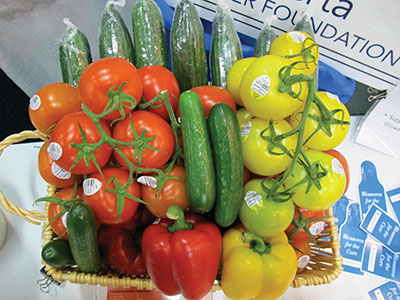 |
|
| Many crops require a little extra help to get to this stage, requiring growers to do some detective work. Advertisement
|
The biggest thing is to train your mind to get out of its comfort zone. While solving problems, it gets used to a certain set of concepts and ideas, and “outside the box” thinking may be required.
Remember also that different “experts” may diagnose the same problem differently. For example, I will keep on working on a problem until it is fully diagnosed and a solution is developed.
The following e-mail from a cucumber grower is a good example.
“Good morning Dr. Mirza. I need to explain and ask for your advice on a very strange situation that has developed here.
“This summer, as we were doing our expansion, I decided that, instead of buying plants from a propagator, I would install propagation gutters in my new high wire greenhouse expansion. The rationale behind this was that I could save money by doing my own propagation, not have any freight charges coming from other areas, and have better control of the quality of the new plants, as much damage can occur from being on a truck for quite a bit of time during the trip.
“Also, part of my rationale included the possibility of being able to grow an older plant, say 26 days, as opposed to the 19-day plants, which is the standard at the propagator. This allows me to leave the old crop in longer and get the new crop into production faster, which is then a big economic saving on my part.
“These propagation gutters are located immediately above the crop truss and about seven feet from the lights. We have a fully lit facility with an intensity of 15,000 lux.
PROBLEMS WITH THE PLANTS ROOTING IN ON THE COCO
■ “I have started three new crops in the last two months and they all germinate and then proceed with slower growth than what I would consider normal. They grow to a certain size, approximately 21 days, and then I place them on the coco where they refuse to root in.
“I am diligent about watering, making sure that a night shot is also given initially, as the coco can tend to steal the moisture from the block to begin with. But with all this, root penetration into the coco is only about one inch and very weak. Normally there should be a good root mass developing in the rockwool block very quickly, and after 21 days of growth when we place it on top of the coco root, penetration should only take two to three days.
“As I said, this has not been happening. As I watch the newly seeded rockwool blocks grow, I am paying particular attention to root development in the block and it is decidedly retarded.
“My consultant has been saying that there is something in the rockwool that the cuke plant is not liking and is suspicious that there is something wrong with the rockwool block. Apparently a wetting agent is added to the rockwool when it is made; the thinking is that this is the cause of the slow and retarded root development. This aspect was ruled out by the supplier of rockwool.
THE PLANT SHUTS DOWN AFTER 10 NODES DEVELOP
■ “When the plant goes on the coco, it continues to grow up to a point and grows very generatively. It loads up with fruit and after 10 nodes develop, the plant completely shuts down.
“At this point the head contains about 10 or more small pieces of fruit and no more leaves. All the leaves that have developed are smaller than what they should be and the colour is bad and there is no root development to support the fruit growth.
“This is all very discouraging as I have always grown great transplants before. In March, I seeded my first cucumber crop myself and it grew very well. After 21 days I placed it on the coco and it rooted in two to three days to a point where it was tight on the block.
“I have been doing a lot of thinking and I sent samples of my affected crop (plant as well as block) to the lab in Holland and I will attach their comments for your information.
“If I look at the fertilizer mix that I was using in March, it contained no urea and now it contains urea and in an increasing amount. I think that this may be our problem. In the meantime I have ordered plants from a propagator to fill the greenhouse to get production back up.
“I am currently still picking from an old crop and it is fed with the same fertilizer mix and in the last two months, although it is still producing, it is suffering from a significant amount of abortion.”
INVESTIGATION BEGINS WITH GREENHOUSE VISIT
■ Here are some pictures I took later on when I visited the greenhouse.
My thoughts went in many directions.
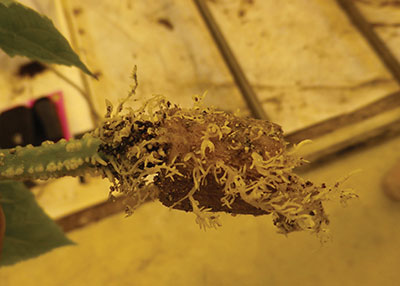 |
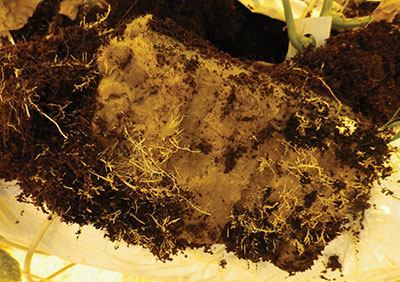
|
1: Young plants become very generative and this may be due to the fact that they are being grown at very high light and high VPD (Vapour Pressure Deficit) levels. Later on, it was shown even the seedlings brought in from propagators behaved in the same manner once planted onto the old coco bags. It took longer to run into the same problem on new bags.
2: It may have something to do with the use of urea that early in the season and at such high amounts.
Based on my thinking, I reworked the fertilizer program, took urea out of it and made adjustments in EC.
When I asked the grower to check the EC in top of the coco bags it was over 5 millimhos, so good leaching was done to bring EC down to 2.5 millimhos. The plants seemed to respond and some new roots appeared to be normal. The strange thing was that a mature crop of cucumbers was growing well although fruit abortion was seen.
SERIOUS ECONOMIC LOSSES OCCURRING
■ The grower called me two weeks later to tell me that the plant response appeared to be temporary and serious economic loss was now occurring.
A site visit was conducted. I made observations on the young crop, old crop, seedlings, temperature regimes and sprays, and reviewed all management practices. Here are a few pictures to share with you.
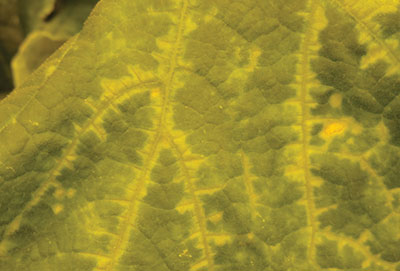
|
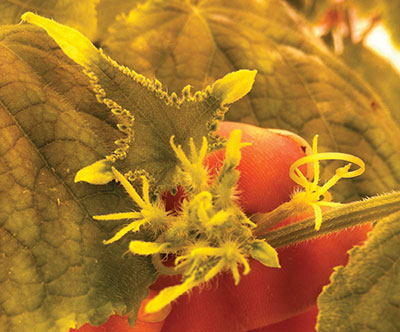
|
The picture on the left shows vein clearing, and the photo on the right shows the top growth.
We discussed the possibility of herbicide contamination of the water. In my mind’s data bank, I was more familiar with phenoxy types of herbicides, such as Picloram, 2,4-D and Dicamba, and did not see the typical symptoms.
It was the grower who mentioned that they started noticing this problem towards the end of September. Typically, the major runoff to a dugout occurs in spring and the herbicide damage is noticed about a month or so later.
The grower immediately sent a water sample to the lab for analysis.
Understanding herbicide analysis is also important. It is expensive, especi-ally if the results are needed quickly and the scope of the herbicide analysis being requested is large. We asked for an “acid herbicide” test that included all the phenoxy types, along with glyphosate, which is Roundup.
LAB RESULTS LED TO A SOLUTION
■ The results of this test helped solve the problem. It showed the presence of Roundup and another product called AMPA. (AMPA stands for “Amino Methyl Phosphonic Acid,” which is a degradation product of glyphosate.) The amount of glyphosate was 12 micrograms/gram, which is 12 parts per billion.
Glyphosate’s mode of action is different than that of phenoxy types of herbicides. If sprayed on leaves, it is absorbed and then moved through the phloem cells to the roots. Phloem is the system through which plant food is transported.
It causes root distortion and absorption of nutrients is affected. In this case, most of the glyphosate was in the growing medium of coir. The roots became stunted and the problems soon developed.
WHAT ACTIONS WERE TAKEN BY THE GROWER?
■ The farm’s well water had high sodium levels, but it was decided to use it until an alternative source of good quality of water was found.
Good quality water was trucked in and used in the irrigation system, and an immediate turnaround was seen in crop.
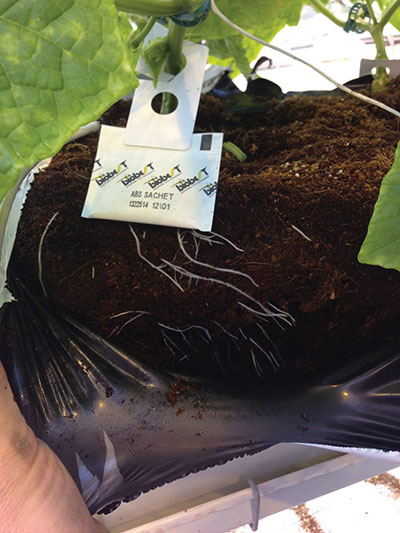 |
|
| Good root development resumed | |
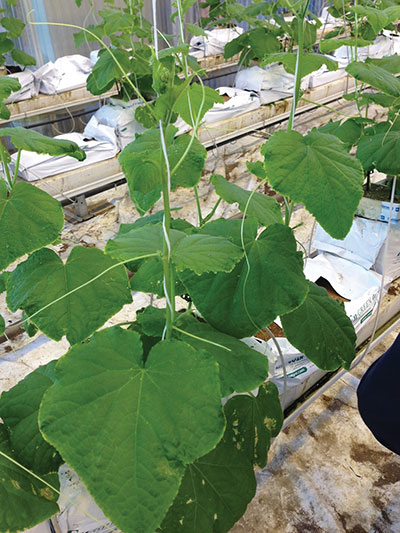 |
|
| Plant health started improving as well.
|
A charcoal filtration system for water was also investigated. Proper flow rates need to be determined for this purpose.
Measures to handle the leach were also studied and proper steps were taken.
Good record-keeping is essential if an insurance company is involved.
How Roundup ended up in dugout water is still the subject of investigation. I learned that thinking outside the box is sometimes needed to diagnose and solve stubborn problems!
Dr. Mohyuddin Mirza is a greenhouse consultant. • drmirzaconsultants@gmail.com
Print this page